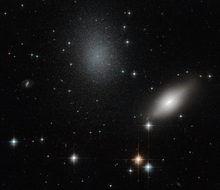NGC 5011
NGC 5011 is an elliptical galaxy in the constellation of Centaurus.[2] It was discovered on 3 June 1834 by John Herschel.[4] It was described as "pretty bright, considerably small, round, among 4 stars" by John Louis Emil Dreyer, the compiler of the New General Catalogue.[4]
| NGC 5011 | |
|---|---|
 HST image of NGC 5011B (right) and NGC 5011C (left) | |
| Observation data (J2000 epoch) | |
| Constellation | Centaurus |
| Right ascension | 13h 12m 51.848s[1] |
| Declination | −43° 05′ 46.25″[1] |
| Redshift | 0.010537[2] |
| Helio radial velocity | 3159 km/s[2] |
| Distance | 133.26 ± 18.56 Mly (40.857 ± 5.692 Mpc)[2] |
| Apparent magnitude (V) | 11.33[3] |
| Apparent magnitude (B) | 12.14[3] |
| Characteristics | |
| Type | E1-2[2] |
| Size | 92,800 ly (28,440 pc)[2][note 1] |
| Apparent size (V) | 1.763′ × 1.552′[1][note 1] |
| Other designations | |
| MGC-07-27-042, PGC 45898[3] | |
Optical companions
Several galaxies are not physically associated with NGC 5011, but appear close to NGC 5011 in the night sky. PGC 45847 is a spiral galaxy that is also known as NGC 5011A.[5] PGC 45918 is a lenticular galaxy[6] some 156 million light-years away from the Earth, in the Centaurus Cluster, and is designated NGC 5011B.[7] PGC 45917 is a dwarf galaxy, also designated NGC 5011C.[8][7] Although NGC 5011B and 5011C appear close together, they are no signs of them interacting.[7] NGC 5011C is actually much closer and is in the Centaurus A/M83 Group, at 13 million light years away.[7]
References
- Skrutskie, M. (2006). "The Two Micron All Sky Survey (2MASS)". The Astronomical Journal. 131 (2): 1163–1183. Bibcode:2006AJ....131.1163S. doi:10.1086/498708.
- "NED results for object NGC 5011". National Aeronautics and Space Administration / Infrared Processing and Analysis Center. Retrieved 6 September 2017.
- "NGC 5011". SIMBAD. Centre de données astronomiques de Strasbourg. Retrieved 6 September 2017.
- "New General Catalog Objects: NGC 5000 - 5059". cseligman.com. Retrieved 6 September 2017.
- "LEDA 45847". SIMBAD. Centre de données astronomiques de Strasbourg. Retrieved 6 September 2017.
- "LEDA 45848". SIMBAD. Centre de données astronomiques de Strasbourg. Retrieved 6 September 2017.
- "Don't trust your eyes | ESA/Hubble". www.spacetelescope.org. 2012. Retrieved 6 September 2017.
- "LEDA 45917". SIMBAD. Centre de données astronomiques de Strasbourg. Retrieved 6 September 2017.
Notes
- 2MASS KS values used.